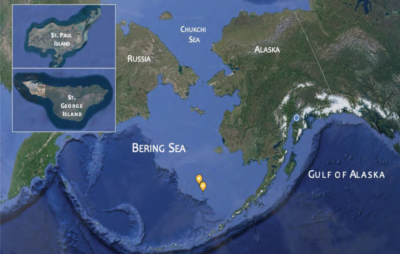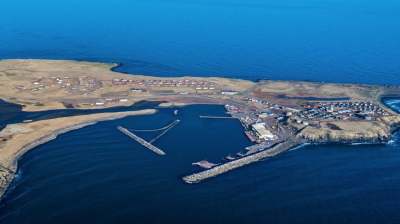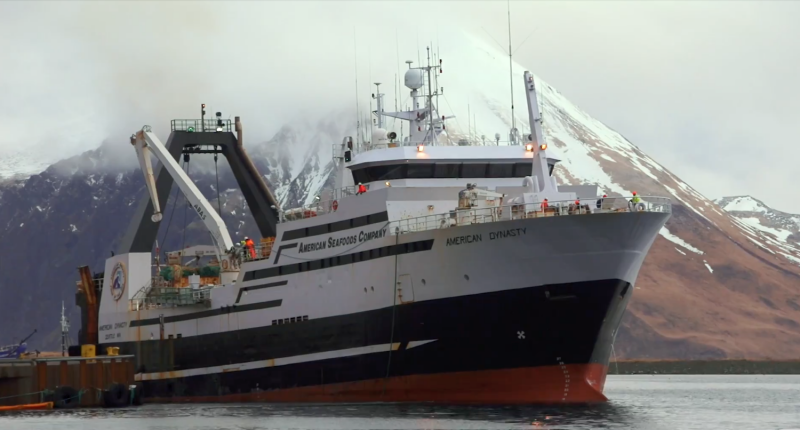It was late August 1998 when I set foot on St. Paul Island, in the Pribilofs, for the first and likely only time. I arrived with two traveling companions by way of a RIB belonging to the American Dynasty, a factory trawler processing surimi in the American Seafoods fleet.
It was sunny but breezy, maybe 20 knots. They brought us ashore on the leeward side of the island. Despite the lee, the chop was rhythmic enough to bounce a lens out of my rickety eyeglasses. It went overboard, of course.
I didn’t complain. I was fortunate to be going ashore, albeit in the middle of the Bering Sea. This was prior to rationalization of the pollock fishery, and the B season would start the following morning. Once the gun went off, the only way I’d get off the Dynasty would be by jumping over the side. If I swam by the Pribilofs, I’d have 200 miles to Dutch Harbor.
I was aboard Dynasty for a story about life on a catcher processor. In the run-up to the B season, Dynasty used its community development quota to find pollock, tune up the factory, and otherwise get ready for the balls-to-the-wall race for fish that was about to commence.
On an earlier occasion, Capt. Jim Susol told me, he had been unable to put a news crew from a Seattle TV station ashore before the gun went off. They remained at sea for 20 days, until the 272-foot Dynasty was full.
American Seafoods had arranged for the three of us — myself, a sales representative from National Fisherman, and a young fishery observer from Texas — to spend the night at the King Eider Inn. I would describe the King Eider as warm and almost dry, befitting its locus on a windswept island in the middle of the Bering Sea. (It has since been renovated.)

Although St. Paul is very much out of the way for humans who live elsewhere — it’s three hours by air to Anchorage — its 42 square miles are otherwise accommodating. Upward of 300 bird species have been observed on the island, including some Eurasians as result of navigational error or unfavorable winds. Steller’s sea lions, Arctic foxes, and reindeer are in evidence as well, and hundreds of thousands of northern fur seals return to rookeries there. St. Paul’s is also known for its wildflowers.
Thus, the King Eider. I leafed through the registry, wondering who might visit such a remote outpost, and discovered a roster of birders and other naturalists.
The inn did not have a restaurant. Instead we were given meal tickets at the Trident plant. We ate pollock in the cafeteria with the workers. Afterward we walked to town, as it were, where we found a general store with a snack bar and a selection of videos for rent. Posted high on the wall behind the counter was a list of overdue videos and their renters. Also on display was a collections of returned personal checks, and next to that, a list of names of those whose check-cashing privileges had been suspended.
We made our way back to the King Eider. Adjacent to the inn was a dilapidated tavern, which I seem to recall was also called the King Eider. A young man, presumably an Aleut — St. Paul is the largest Aleut community in the United States — was gazing out the window. It seemed to me a logical next stop.
I didn’t get any takers among my traveling companions. Whether it was because we obviously weren’t locals I couldn’t say. The writer in me said, “In you go,” so in I went.
The small place was like a million other bars. It was crowded with mostly young men and women, several of whom were playing darts, and football was on TV. I sat down at an open table and ordered a beer from a waitress. Not many minutes later a man I would describe as middle-aged walked up to the bar and rang a bell. A few minutes later the waitress came over with another beer.
Taking pains to be polite, I said didn’t order the beer. The waitress explained that when someone rings the bell, they buy a round for the house. (It’s a tradition I have since learned is hardly unique to St. Paul.) I told the waitress thanks anyway, but I was all set. She left the beer.
In short order the bell ringer came over and asked me what the matter was. He was not confrontational and he, too, explained the local custom. I told him the misunderstanding was all mine and that I was looking forward to drinking his beer.
I finished my two beers and slinked out of the place. Before I left a white man came in what I took for a cop’s or sheriff’s uniform. Someone said he was with the Coast Guard, which I guess explained things. He didn’t have anything to drink and stayed no more than a minute or two. I surmised he had a message for someone.
The next morning, we boarded an old Lockheed Electra, a four-engine turboprop operated by Reeve Aleutian Airways, bound for Anchorage, a world away.
Throughout my short stay I looked upon St. Paul Island with journalistic detachment, but it wasn’t lost on me that it’s a special place, especially to people who call it home — and one that won’t be replicated. Yet if Bering Sea snow crab, whose population, in billions of animals, collapsed in 2022, remains disappeared, relocation will be a real prospect for many. Millions of dollars in landing tax revenues and support services disappeared with the crabs. The Trident processing plant, which employed hundreds seasonally (mostly from away) is shuttered. It seems unlikely that the local halibut fishery can support the community.
It takes stoic resilience to thrive on an island where the pace of life is measured in changing seasons, among them a long, dark winter. St. Paul is casting about for alternatives to snow crab. Perhaps the processing plant can turn to other fisheries. Mariculture is a prospect.
Still, residents of St. Paul residents today come of age digitally connected to a world that to many may seem as lush with opportunity as St. Paul is with life. The younger one is, it seems to me, the harder it will be to resist that call.
It’s one more reason to hope and pray for the people of St. Paul and their mystical island. And to glance over our shoulders and hope and pray there isn’t a disappearing act coming for the rest of us.








